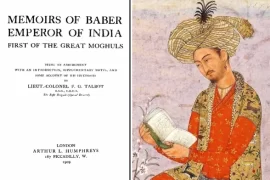
It’s not only the story of the IAF’s (Indian Air Force) pivotal role and contribution to Bangladesh’s war for independence. But rather a saga based on actual details of two air forces of the subcontinent, one belonging to India and the other to Pakistan. The 1971 war for the Indians may have ended in about two week time but not without the Indian air force emerging as a formidable fighting force that facilitated the Indian army’s rapid progress to Dhaka.
But it should be made clear that the open war that broke out between the two arch rivals along the two fronts is not the centre point of the book as the book is aptly titled “Eagles over Bangladesh”. With few bits of sporadic details about the air battles in the western front the book mainly highlights on the role of the Indian air force’s Eastern Air Command which had its airfields scattered around West Bengal, Meghalaya and the north eastern states with its headquarters in Shillong. During the 1971 war, Eastern Air Command was tasked with offensive air strikes, close support missions and supply operations.
The first two chapters of the book begin with an eye-opening introduction about the IAF’s years between the ’65 and ’71 wars with Pakistan while giving an incisive brief on how the IAF along with its nefarious foe PAF had organised their strengths, formed and commanded their air forces progressively during the years between the wars that even takes the reader back to the post-partition days. The intro is complemented farther with a touch-up of historic and dramatic stages leading Bangladeshis to fight for their independence with an anecdote of the ‘Kilo flight’- formation of light aircrafts (called Kilo flight) which were manned and serviced by Bengali pilots and technicians who had defected from the Pakistani Air Force. Thus the path for Bangladesh Air Force was paved.
It’s from the third chapter that the reader starts to get glued to the book with short but live descriptions of initial clashes and dog fights between the PAF and IAF. Knowing full well about IAF’s considerable air might the PAF armed with a lone F-86 Sabre squadron to defend its skies in the east was not only helpless but also lacked efficient and courageous leadership. Deployment of only a squadron of F-86 Sabre jets in the East also shows West Pakistan’s clear military discrimination to the East. PAF, if desired, could have utilised its limited air strength to the full of its capability. Why it did not is still a mystery. However, its pilots displayed courage and efficiency in air-to-air combat during the initial period of the war, till it was neutralised in less than 72 hours after India had entered the war.
However among all the battles fought in the air, it’s the battle over the skies of Boyra which is perhaps the most evenly fought by the two sides. It was aerial interception combat fought between the two sides well before the Indians had officially declared war against Pakistan on the 22nd of November, 1971. Moreover it was the first engagement through air battle in 1971.
This action took place in front of thousands of people, became one of the most enduring moments of our liberation war and made all four Indian Pilots instant celebrities in India and Bangladesh overnight. Their pictures, Gun camera Images of the flaming sabres and those of the PAF prisoners of war was widely circulated by the media across the world. This engagement marked the first time in 6 years (after the 1965 war) that aircraft were shot down in air combat in the Indian Subcontinent and the state of increased hostilities in the region culminated the Indo-Pakistani War of 1971, that in the end played a vital role in the creation of the Peoples Republic of Bangladesh less than a month later.
The fourth chapter in particular displays vivid account of a few air-to-air combats over the skies of Dhaka and that’s it. After the fourth it’s all about how the IAF functioned unopposed in the skies of then East Pakistan. Till the instrument of surrender was signed on December the 16th there was only one strategic bombing campaign carried out that’s noteworthy and that is the bombing of the then governor’s house located near the national stadium.
Other features scattered across the chapters of “Eagles over Bangladesh” that needs mentioning are the close cover and air support provided by the IAF, the hundreds of reconnaissance sorties flown by the IAF, PAF’s discriminatory treatment of Bengali pilots, the primitive days of Bangladesh Air force, the committed role of the Pakistani anti-aircraft gunners, repeated bombing of the Tejgaon airport’s runway and of course the tales of a bunch of brave Indian pilots of a time gone by.
To sum up: the book is a treasure-trove for the one who regularly sneaks in to events of our liberation war, and the trove is prepared at the cost of 8 years of painstaking efforts undertaken by the Indian authors P.V.S Jagan Mohan and Samir Chopra. Some of the black and white pics of the book gave a nostalgic kick while reviewing. On top of everything it’s available in Dhaka within a price range of a thousand taka.
The writer is a Current Affairs Analyst.







